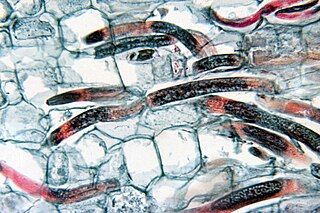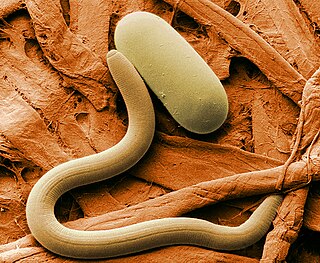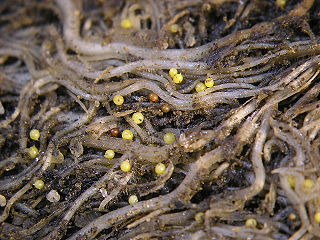Northern root-knot nematode is a species of vegetable pathogens which produces tiny galls on around 550 crop and weed species. They invade root tissue after birth. Females are able to lay up to 1,000 eggs at a time in a large egg mass. By surviving harsh winters, they can survive in cold climates.

Root-knot nematodes are plant-parasitic nematodes from the genus Meloidogyne. They exist in soil in areas with hot climates or short winters. About 2000 plants worldwide are susceptible to infection by root-knot nematodes and they cause approximately 5% of global crop loss. Root-knot nematode larvae infect plant roots, causing the development of root-knot galls that drain the plant's photosynthate and nutrients. Infection of young plants may be lethal, while infection of mature plants causes decreased yield.

Radopholus similis is a species of nematode known commonly as the burrowing nematode. It is a parasite of plants, and it is a pest of many agricultural crops. It is an especially important pest of bananas, and it can be found on coconut, avocado, coffee, sugarcane, other grasses, and ornamentals. It is a migratory endoparasite of roots, causing lesions that form cankers. Infected plants experience malnutrition.

The soybean cyst nematode (SCN), Heterodera glycines, is the most devastating pest to soybean crop yields in the U.S., targeting the roots of soybean and other legume plants. When infection is severe SCNs cause stunting, yellowing, impaired canopy development, and yield loss. The symptoms caused by SCNs can go easily unrecognized by farmers—in some cases there are no warning symptoms before a loss of 40% of the yield. Due to the slight stunting and yellowing, many farmers may mistake these symptoms as environmental problems when in fact they are SCNs. Another symptom of SCNs that may affect farmers' yields is stunted roots with fewer nitrogen-fixing nodules. Due to the fact that soybean cyst nematodes can only move a few centimeters in the soil by themselves, they mostly are spread via tillage or plant transplants. This area of infection will look patchy and nonuniform making diagnosis more difficult for farmers. They can be seen in the roots of summer soybean plants if the roots are taken out very carefully and gently washed with water. The egg masses should be seen as bright white or yellow "pearls" on the roots. The later the roots are pulled the harder it will be to diagnose due to the SCNs female dying and turning a much darker color, forming a "cyst". The best way to know if a field is infected by soybean cyst nematodes is to take a soil sample to a nematologist.

White mustard is an annual plant of the family Brassicaceae. It is sometimes also referred to as Brassica alba or B. hirta. Grown for its seeds, used to make the condiment mustard, as fodder crop, or as a green manure, it is now widespread worldwide, although it probably originated in the Mediterranean region.

Potato root nematodes or potato cyst nematodes (PCN) are 1-mm long roundworms belonging to the genus Globodera, which comprises around 12 species. They live on the roots of plants of the family Solanaceae, such as potatoes and tomatoes. PCN cause growth retardation and, at very high population densities, damage to the roots and early senescence of plants. The nematode is not indigenous to Europe but originates from the Andes. Fields are free from PCN until an introduction occurs, after which the typical patches, or hotspots, occur on the farmland. These patches can become full field infestations when unchecked. Yield reductions can average up to 60% at high population densities.

Rotylenchulus reniformis, the reniform nematode, is a species of parasitic nematode of plants with a worldwide distribution in the tropical and subtropical regions.

Meloidogyne arenaria is a species of plant pathogenic nematodes. This nematode is also known as the peanut root knot nematode. The word "Meloidogyne" is derived from two Greek words that mean "apple-shaped" and "female". The peanut root knot nematode, M. arenaria is one of the "major" Meloidogyne species because of its worldwide economic importance. M. arenaria is a predominant nematode species in the United States attacking peanut in Alabama, Florida, Georgia, and Texas. The most damaging nematode species for peanut in the USA is M. arenaria race 1 and losses can exceed 50% in severely infested fields. Among the several Meloidogyne species that have been characterized, M. arenaria is the most variable both morphologically and cytologically. In 1949, two races of this nematode had been identified, race 1 which reproduces on peanut and race 2 which cannot do so. However, in a recent study, three races were described. López-Pérez et al (2011) had also studied populations of M. arenaria race 2, which reproduces on tomato plants carrying the Mi gene and race 3, which reproduces on both resistant pepper and tomato.

Pratylenchus penetrans is a species of nematode in the genus Pratylenchus, the lesion nematodes. It occurs in temperate regions worldwide, regions between the subtropics and the polar circles. It is an animal that inhabits the roots of a wide variety of plants and results in necrotic lesions on the roots. Symptoms of P. penetrans make it hard to distinguish from other plant pathogens; only an assay of soil can conclusively diagnose a nematode problem in the field. P. penetrans is physically very similar to other nematode species, but is characterized by its highly distinctive mouthpiece. P. penetrans uses its highly modified mouth organs to rupture the outer surface of subterranean plant root structures. It will then enter into the root interior and feed on the plant tissue inside. P. penetrans is considered to be a crop parasite and farmers will often treat their soil with various pesticides in an attempt to eliminate the damage caused by an infestation. In doing this, farmers will also eliminate many of the beneficial soil fauna, which will lead to an overall degradation of soil quality in the future. Alternative, more environmentally sustainable methods to control P. penetrans populations may be possible in certain regions.

Heterodera avenae, the cereal cyst nematode or European cyst nematode, is a plant pathogen and an obligate parasite of cereal crops including barley, oats, wheat and rye. Cereal crops infected with this nematode are more susceptible to infection by fungal diseases such as rhizoctonia root rot.
Heterodera humuli is a plant pathogenic nematode, the hop cyst nematode. It is an obligate parasite and infests hop plants, Humulus lupulus.

Paratylenchus hamatus, the fig pin nematode, is a species of migratory plant endoparasites, that causes lesions on plant roots resulting in symptoms of chlorosis, wilting and ultimately yield losses. They move and feed on different parts of host tissue throughout their life cycle in order to find enough susceptible host tissue to survive and reproduce. A wide range of host plant species are susceptible to the fig pin nematode, including many valuable fruit and vegetable crops such as figs, carrots and celery. They are also commonly found associated with woody perennials in California. P. hamatus inhabits soils in both Europe and North America, and was originally isolated from fig in central California in 1950.
Mesocriconema xenoplax is a species of plant parasitic nematodes. Nematodes of this particular species are collectively called ring nematodes.

Heterodera is a genus of nematodes in the family Heteroderidae. Members of the genus are obligate parasites and different species attack different crops, often causing great economic damage. The genus is unique among nematode genera because of the ability of the female to transform into a tough, brown, cyst which protects the eggs which have been formed within her body. The name heterodera "refers to the different 'skins' of female and cyst."
Heterodera sacchari, the sugarcane cyst nematode, mitotic parthenogenic sedentary endoparasitic nematode. This plant-parasitic nematode infects the roots of sugarcane, and the female nematode eventually becomes a thick-walled cyst filled with eggs. Aboveground symptoms are species specific and are similar to those caused by other Heterodera species. Symptoms include: stunted and chlorotic plants, and reduced root growth. Seedlings may be killed in heavily infested soils.
Heterodera medicaginis, the alfalfa cyst nematode, is a plant pathogenic nematode which is cited as an invasive species. It is closely allied to Heterodera daverti, H. glycines and H. sonchophila in the H. schachtii-group. The only known host plant of this obligate parasite is the important crop alfalfa or lucerne, Medicago sativa.

Pratylenchus is a genus of nematodes known commonly as lesion nematodes. They are parasitic on plants and are responsible for root lesion disease on many taxa of host plants in temperate regions around the world. Lesion nematodes are migratory endoparasites that feed and reproduce in the root and move around, unlike the cyst or root-knot nematodes, which may stay in one place. They usually only feed on the cortex of the root. Species are distinguished primarily by the morphology of the stylets.
Globodera tabacum, commonly known as a tobacco cyst nematode, is a plant parasitic nematode that mainly infests the tobacco plant, but also plants in family Solanaceae.
Pratylenchus alleni is a migratory endoparasitic nematode, living inside of plant roots and feeding on parenchyma cells in the root cortex. P. alleni is an obligate biotroph, meaning it must have a living host in order to survive. Due to their incredibly broad host range, Pratylenchus species fall third in total economic impact, finishing just behind cyst nematodes and root knot nematodes (Meloidogyne). In Canada, it was isolated for the first time in 2011 in a soybean field.
Heterodera zeae, the corn cyst nematode (CCN), is a plant parasitic nematode that feeds on Zea mays (maize/corn). The CCN has a limited economic impact worldwide due to its high soil temperature requirements.











